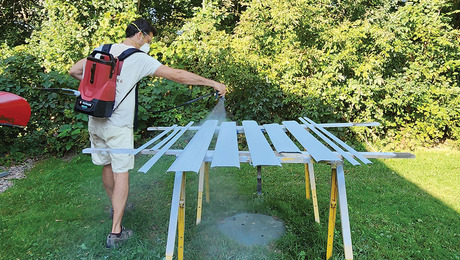I’m looking to buy a good hand plane for setting the angle and sizing doors.
I want to purchase a good hand plane for setting the angle on the latch side of wood doors and shaving the door edge when needed. I am considering a No. 4 smoothing plane. I’m not sure if I should spend the money on a Lie-Neilson or purchase a lesser priced plane. Any feedback would be appreciated.















Replies
The door plane of choice that was in every carpenters tool box was a #7, Stanley, Miller's Falls, Sargent, Record, and a number of names that were actually made by Stanley/Bailey. The #7 gives you the extra tracking length for long edges. Shorter planes may have a tendency to put some wavyness in the edge. You can always find some #7s on EBay that aren't too expensive but they usually need what is called, "tuning" as well as some rust removal. It helps to have an educated eye so you know the good ones from ones to avoid.
Part of the tuning process may be flattening the sole of the plane, that's been the case with many I've bought. To do it properly, you sand the cast iron with a relatively fine abrasive by hand, running the plane as you would use it on a flat surface with the abrasive/sandpaper attached to that surface. It's a long hard job on a #7 or #8. #7C has a corrugated sole and this means less iron to remove in the flattening process. Of course there is other work to do, sharpening the blade, fitting the chipbreaker, adjusting the frog, often refinishing the tote and knob. Some of us enjoy restoring old planes and putting them back in service.
To avoid all this, you can buy a Lie Neilsen. It's a copy of the Stanley Bailey design but more refined, available in bronze, sharpened and ready to use out of the box. Although expensive, it's cheap comparted to the time you may spend resurecting an old one. With a little adjustment on the blade depth, the LN will show you what a proper plane should work like. A top of the line plane that will not dissappoint.
There are other options. I won't go into power tools, of which there are several to do the job. New iron planes in various price ranges can be had, Wood River, Groz, Annant, Kunz. These are not as refined as LN and may need some tuning and sharpening. Clifton makes a very nice iron plane. Many folks like Veritas which have some more modern designs. There are also wood jointer planes by ECE and Ulmia, less heft than iron but a nice feel on the wood. Another type of plane people like are the low angle, bevel up ones like the Veritas jointer from Lee Valley, there is a fence available for this plane which helps keep it square to the work. To angle the cut, you angle the blade which is how you would use the more standard bevel down planes, too. You will have to be able to sharpen blades with any plane and many new ones will require it before use.
Remember, the hinge edge is traditionally backed as well to avoid door being hinge bound. I plane both edges before I route or bore my doors. I also choose to use a power plane (Festool now) to set the 2-3 degree bevel. It's so much faster (as well as precise) if your hanging doors for a living. With todays composite cores and mixed grain fillers, the carbide edges on power planes hold up better as well. Don't get me wrong, I respect the functionality of a well honed plane iron and one can put a razors edge on easily with a Tormek grinder and Jap stone(s), but most of my planes are in my shop for furniture work...to be used on my own time. The only exception is my LN low profile bronze block plane which is indespensible for scribe fitting mouldings and flat trim and goes wherever I go to work.